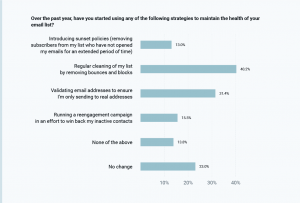Marketing teams must have visibility over key business goals, in order to align their work with broader company ambitions. This can have a significant impact on business success, startup growth, and sustainability of your digital marketing activities.
A recent study found that companies with a strong alignment between sales and marketing achieve a 20% annual growth rate, as opposed to a 4% decline in revenue for companies with poor alignment.
Depending on where your business is within its own lifecycle, the growth you’re looking for from your marketers can vary dramatically.
If you operate as an established business, you may be looking toward methods for maximising steady user growth and return customers – and thus focusing on the most efficient ways to achieve this. If you are a young startup preparing for an IPO, it’s likely that more of your attention will be focused on monetisation and fast-growth revenue; a different goal requiring a different set of tools and skills.
Indeed it is important to have your marketers adopt a flexible approach, so they’re open to support change in focus, ultimately determined by the board level leaders, investors, and strategists.
Different techniques have specific action and reaction. For example, the use of social media and influencer marketing for building brand awareness, Google AdWords / PPC to generate fast-growth and signups, or search engine optimisation (SEO) for driving a steady stream of leads over time.
Depending on your audience and business goals, tactics often have the best outcome when used in combination. Each approach will have a different associated value, as part of a wider business growth plan. Iterative testing is essential.
Measure What Matters
When, in digital marketing, literally every movement can be measured, every click counted, and every second analysed, every resource you use can be optimised to maximise your return on investment.
Set up goals in an interpretive tool like Google Analytics, to monitor when your users are completing the journeys that you’ve laid out.
For example, this could consist of spending a certain amount of time on-site, submitting a contact form enquiry, downloading a PDF, or purchasing a product through your eCommerce portal. This needs to be attributed to the channel that brings the visitor; whether it be a PPC, SEO, or otherwise.
This will assist your pursuit of what works and what doesn’t. As a result, and through regular iterative tests and a methodological approach, your startup can allocate more budget to the tactics that are most effective in reaching your goals.
Track as many areas of significance as possible. This should be done as early as possible, to maximise the pool of data and educate future strategies. Marginal gains make a big difference over time, so the more evidence you have of success and failure, the better.
Talk to one another
Marketers must tailor their approach to the needs of the startup business, which means they must know the end-result and higher level goals. Having an in-depth knowledge of the priorities of the business is essential. Communication between CMOs and CEOs has to be a constant exchange of ideas and results to ensure progress is going in the right direction, and this should be effectively communicated to all executives and outsourced agencies.
Within fast-paced startups, this is usually quite straightforward. The small and nimble teams ensure that information is filtered down the (often non-hierarchical) pyramid. This is critical to quick collaborative thinking, and paramount when priorities can change overnight.
Whilst regular informal meetings can take care of the day-to-day workings, a more formal line of communication should also be established, and adhered to. This provides a structure for the business to ensure that all teams are working to the same end, so there’s no playing catch-up.
SaaS tools can help in this regard, for internal and external parties. Later in the article, I’ll outline some of the best tech solutions to assist with team communication and collaboration. This technology must be coupled with a clear directive from business leaders.
Alignment For Third Party Agencies
The same communicative principles apply when outsourcing activities to third parties. This alignment should not be breached, and collective awareness of business goals and brand values is essential.
Outsourcing is an effective way of not bogging down time and resources in the search and hire of full-time employees with long-term commitment – which is particularly painful and risky for startups. However, the use of external teams does come with its own set of challenges.
First and foremost, there’s the danger of being tied into a contract with a supplier who doesn’t understand your startup goals and ambitions. A common issue is the poor reflection of brand values and tone of voice in content. Furthermore, some outsourced agencies fit your requirements into their setup, rather than tailoring a solution to your specific needs.
Avoid this by choosing third party suppliers carefully. Note their attention to core goals, and establish whether ambitions, requirements, and capabilities align. A joint focus on how targeted digital marketing activities should impact bottom-line success is key to a mutually beneficial relationship.
One challenge to outsourcing can be that of geography. The right external team may be on a different continent, in a different time-zone. This can be a challenge to alignment and communication, but luckily there are a number of tools at our fingertips which ease the pain.
Here’s a concise list of what you may consider:
- Internal social networks, such as Yammer
- Project management tools, such as Asana or Trello
- Shared document repositories, such as Google Drive or Dropbox
- Instant messaging services, such as Slack
- Video conferencing tools, such as GoToMeeting or Skype
By communicating regularly and effectively, you can ensure that outsourced teams harbour the same strategic vision, and perspective of the bigger business picture for coming years.
Communicative Priorities
The priorities remain the same, whether you’re incorporating an internal or external team. It’s imperative to have regular transparent catch-ups with both groups of executives. On average, once per week is recommended unless a significant change of focus is underway; in which case, this contact should be more frequent.
Regularity will provide all parties with the opportunity to discuss performance, targets, and obstacles blocking success.
By being up-front with a startup’s business plan, leaders can help internal and external teams work more effectively towards broad business missions. Ethos and values should be communicated in-line with business goals, so all teams can work with these in mind.
Set out clearly what’s expected in macro and micro terms, establish how individual and team success will be measured, and clarify what your role will be as a leading figure. Create a harmonious working relationship, as far as can be controlled by processes and culture.
Summary
Ultimately, it’s in every startup’s best interests to ensure that marketing strategy aligns directly with goals and priorities of the business. There’s no benefit in embarking on a tactical digital marketing campaign without understanding its potential contribution to direct business growth.
Some startup founders merely wish to develop an online presence, which will aid in the awareness about their brand. However, with more B2B and B2C web users increasingly likely to use online channels throughout the buying process, digital effectiveness has become much more than a nice-to-have. It’s a critical element to business growth.
This focus needs to start in the early days, when the startup is founded, so it can be instilled as an integral part of the company’s culture as it grows. By making a consumable form of your business plan accessible to internal and external teams, you can encourage open discussion across various departments, whilst ensuring that everybody is motivated by the same company vision.
Transparency, communication, and collaboration will reap rewards. Meticulous alignment of activities with key business goals will drive growth in the areas that are most important. Regular measurement of tests will inform a methodological approach to success.
(65)
Report Post





